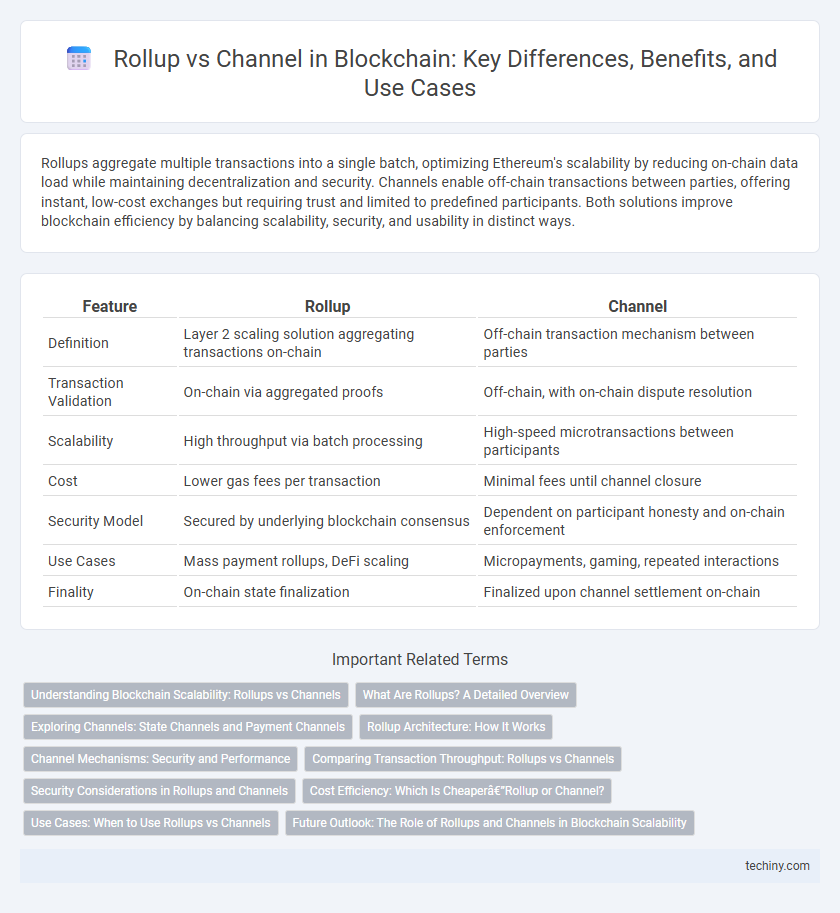Rollups aggregate multiple transactions into a single batch, optimizing Ethereum's scalability by reducing on-chain data load while maintaining decentralization and security. Channels enable off-chain transactions between parties, offering instant, low-cost exchanges but requiring trust and limited to predefined participants. Both solutions improve blockchain efficiency by balancing scalability, security, and usability in distinct ways.
Table of Comparison
| Feature | Rollup | Channel |
|---|---|---|
| Definition | Layer 2 scaling solution aggregating transactions on-chain | Off-chain transaction mechanism between parties |
| Transaction Validation | On-chain via aggregated proofs | Off-chain, with on-chain dispute resolution |
| Scalability | High throughput via batch processing | High-speed microtransactions between participants |
| Cost | Lower gas fees per transaction | Minimal fees until channel closure |
| Security Model | Secured by underlying blockchain consensus | Dependent on participant honesty and on-chain enforcement |
| Use Cases | Mass payment rollups, DeFi scaling | Micropayments, gaming, repeated interactions |
| Finality | On-chain state finalization | Finalized upon channel settlement on-chain |
Understanding Blockchain Scalability: Rollups vs Channels
Rollups aggregate multiple off-chain transactions into a single on-chain proof, significantly reducing data load and enhancing Ethereum's scalability. State channels facilitate rapid, private transactions between participants by conducting multiple exchanges off-chain and settling net results on-chain, minimizing latency and fees. Both methods address blockchain scalability by optimizing transaction throughput and reducing on-chain congestion, with rollups focusing on data compression and channels prioritizing off-chain interaction.
What Are Rollups? A Detailed Overview
Rollups are Layer 2 scaling solutions that bundle numerous off-chain transactions into a single proof submitted to the main blockchain, significantly increasing throughput and reducing gas fees. They execute transactions off-chain while ensuring security through cryptographic proofs, primarily utilizing Optimistic and ZK-Rollup variants. Rollups enhance Ethereum's scalability by processing large volumes of transactions efficiently without compromising decentralization or security.
Exploring Channels: State Channels and Payment Channels
State channels enable off-chain transactions by allowing multiple interactions between participants without updating the main blockchain, significantly improving scalability and reducing fees. Payment channels, a subtype of state channels, specifically facilitate rapid, low-cost, trustless micropayments by locking funds in a multi-signature wallet accessible by both parties. Both mechanisms enhance blockchain efficiency by minimizing on-chain congestion while maintaining security through cryptographic proofs.
Rollup Architecture: How It Works
Rollup architecture aggregates multiple off-chain transactions into a single batch submitted on-chain, significantly enhancing blockchain scalability by reducing data load and transaction costs. It leverages a single smart contract to verify the correctness of off-chain computations through cryptographic proofs, ensuring security without compromising decentralization. This mechanism contrasts with payment channels by providing broader compatibility with complex smart contracts and enabling greater throughput for decentralized applications.
Channel Mechanisms: Security and Performance
Channel mechanisms in blockchain enhance security by enabling off-chain transaction processing, reducing the risk of on-chain congestion and potential attacks. These channels maintain performance efficiency through fast transaction finality and lower latency by minimizing on-chain interactions while preserving trust via secured cryptographic commitments. Compared to rollups, channels provide direct peer-to-peer scalability solutions with instant transaction validation but may sacrifice some decentralization depending on the channel's design and trust assumptions.
Comparing Transaction Throughput: Rollups vs Channels
Rollups achieve significantly higher transaction throughput by batching multiple transactions into a single proof submitted on-chain, enabling hundreds to thousands of transactions per second depending on the implementation type, such as Optimistic or ZK-Rollups. Payment channels, while offering near-instant and highly scalable off-chain transaction speeds, are limited by the number of participants and require pre-funded locked deposits, restricting throughput to the channel's capacity and participant arrangement. Rollups provide more scalable blockchain-wide throughput enhancement, whereas channels optimize for micropayments between fixed parties with minimal on-chain interaction.
Security Considerations in Rollups and Channels
Rollups enhance security by posting transaction data directly on the main blockchain, enabling robust fraud proofs and data availability guarantees that help prevent invalid state transitions. Channels rely on off-chain transaction exchanges secured through cryptographic signatures and mutual participant cooperation, but face risks like counterparty default and limited dispute resolution mechanisms. Both approaches demand careful design to mitigate potential attack vectors, though rollups generally offer stronger security assurances due to on-chain data anchoring.
Cost Efficiency: Which Is Cheaper—Rollup or Channel?
Rollups aggregate multiple transactions into a single batch, significantly reducing on-chain gas fees compared to executing each transaction individually, making them highly cost-efficient for high-volume use cases. Channels, such as payment channels, minimize on-chain interactions by conducting numerous off-chain transactions, with only opening and closing settlements recorded on-chain, which can be cheaper for frequent, small-value transactions. Cost efficiency depends on usage patterns: rollups are more economical for large-scale decentralized applications requiring frequent state updates, while channels excel in scenarios with repetitive, bilateral transactions.
Use Cases: When to Use Rollups vs Channels
Rollups excel in scenarios requiring high throughput and security, such as decentralized finance (DeFi) applications and complex smart contract execution, by aggregating multiple transactions into a single batch on the main blockchain. Channels are ideal for micropayments and frequent off-chain interactions between a limited set of participants, like payment channels in gaming or IoT devices, where instant finality and low fees are critical. Choosing rollups suits applications needing scalability without compromising on-chain validation, while channels are best for low-latency, trust-minimized instant transactions within a predefined group.
Future Outlook: The Role of Rollups and Channels in Blockchain Scalability
Rollups enhance blockchain scalability by bundling multiple transactions into a single proof, significantly reducing on-chain data and improving throughput for Layer 2 solutions. Channels enable off-chain transaction processing between parties, offering near-instant finality and minimal fees but limited to participants within the channel. The future of blockchain scalability likely involves hybrid models combining rollups' broad applicability with channels' efficiency in specific use cases, optimizing performance and decentralization.
Rollup vs Channel Infographic

 techiny.com
techiny.com